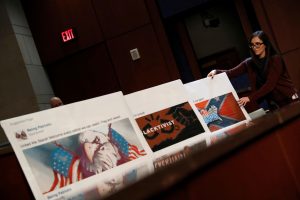American Story
The American Story: From Washington to Roosevelt, Reagan and Beyond

Parson Weems’ Fable, Grant Wood – 1939
[The following is an illustrated version of the lecture given by Dr. Cynthia M. Koch at the FDR Foundation’s Telling Our Story conference November 10, 2015]
Defining the identity of the new United States, what we might call the “master narrative,” was one of the many tasks facing our founding fathers and mothers in the 1790s.
The new nation lacked all the usual markers for nationhood: no established religion, no dominant ethnicity, no monarchy or aristocracy. No folklore and—most important—no shared history.
Most Americans had a common language, but of course it was English—and distinguishing the new United States from England was essential if the nation was to achieve the full measure of its independence. The thirteen different colonies with their different religions, economies, traditions, and racial and ethnic make-up had one thing in common: the experience of the Revolutionary War.
And the American Revolution was indeed unique: a republic founded on the Enlightenment principles of universal human rights of liberty, equality, and freedom. Moreover, it was a New World republic, existing far from the metropolitan centers of Europe on the edge of a continent, much of which was still considered “wilderness,” and inhabited by indigenous people.
Many were concerned with defining the new nation and its identity, but it fell to a group of history-writers to craft the most enduring narrative.
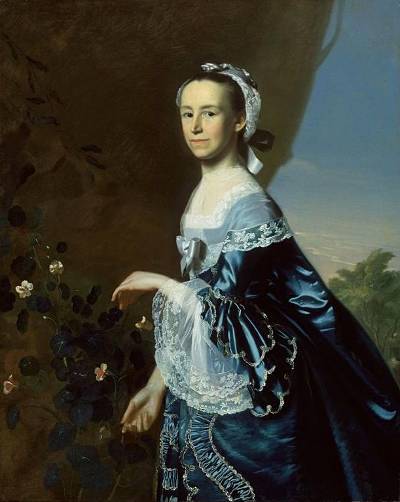
Mercy Otis Warren
They were six men and one woman, all witnesses to the American Revolution: John Marshall, the first Supreme Court chief justice had served under Washington at Valley Forge; David Ramsey and Hugh Williamson were surgeons in the Continental Army; Edmund Randolph accompanied Washington to Boston as an aide-de-camp before he became a Virginia delegate to the Continental Congress. Jeremy Belknap, Benjamin Trumbull, and William Gordon were Congregational clergymen who ministered to the troops in the field. Mercy Otis Warren, whose brother and husband were famous Boston patriots, wielded her pen, she said, in part because her gender denied her the opportunity to take up “manly arms.”
“Deeply moved by what they had witnessed during the momentous 1770s, they wrote their country’s first narrative, filled with stories of heroism and virtue generated by the war.”1
Theirs was a history of “fresh beginnings and founders’ intentions,” which interpreted the Declaration of Independence as the “culmination of a long colonial gestation period.”
According to historian Joyce Appleby, from whom I am borrowing liberally, “These original efforts served as a template for successive reworkings of the story of American nation-building.”2
And, as we shall see, the essential outlines of the narrative endured well into the 20th century.
The first historians stressed not only that America was the rightful inheritor of the Enlightenment principles, but that it was “the last best hope of mankind” in the struggle for freedom in the face of the corrupt institutions of old-regime Europe. George Washington and the leaders of the Revolution came to represent civilization’s irrepressible quest for democratic nationalism.3
As these early formulations were popularized in the 19th century, the Revolution was made to seem the inevitable end of a long sequence of foreshadowings from colonial history—the Mayflower Compact, John Winthrop’s City on a Hill, surviving the “starving time” at Jamestown, Washington’s “Father, I cannot tell a lie,” Penn’s Treaty with the Indians, the Pocahontas-John Smith story, and the first Thanksgiving.
All of these and many more fed into the founding narrative of a nation that would be an exemplar to the world.
But “[t]here was no place in this narrative for examining the variety of complex reasons that had brought Europeans to the North American continent, much less for taking stock of the enslavement and expulsion of peoples whose cultural values called into question the claimed universality of American ideals.”4
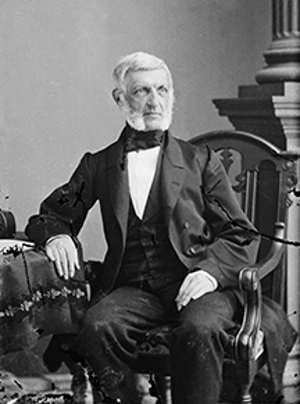
George Bancroft
George Bancroft’s History of the United States, the first complete history of the nation, was written during the middle decades of the 19th century. He added ideas of a democratic spirit, which with divine guidance, drove American expansion across the continent.5 Bancroft made the settler families of the land west of the Appalachians the carriers of a new and vibrantly democratic civilization.
These “pioneers” were never depicted as invaders, even though blood was always spilled before any land was opened up for settler occupation. Instead [Appleby again] “the iconography and literature of the westward movement invoked a peaceful tableau in which the sunburned and hardy pioneer father walked beside his Conestoga wagon, Bible in his hand, his rifle at the ready should any hostile force attempt to repel his ‘castle on wheels.’”
This narrative served both American democracy and nationalism by celebrating the courage and fortitude of ordinary white citizens and by justifying the seizure of territory long occupied by Native Americans.6
The pioneers were a brave, resilient, and industrious people, continually renewing themselves and the nation by their expansion of the frontier.
This story of new beginnings included only white Americans, not those still held in slavery or driven from their ancestral lands. The Mexican War, Civil War and Reconstruction, the Indian Wars, and the social dislocations brought about by industrialization and immigration did little to change the master narrative.
In 1893 historian Frederick Jackson Turner famously declared the frontier “closed” and defined the nation in terms of an American type that suited equally well the “pioneer” and the ethos of the titans shaping the new industrial economy: “coarseness and strength combined with acuteness and inquisitiveness; that practical inventive turn of mind . . . that masterful grasp of material things, lacking in the artistic but powerful to effect great ends; that restless, nervous energy, that dominant individualism with the buoyancy and exuberance which comes with freedom.7
This was the American and his narrative: Inheritor of the Revolutionary principles of the rights of man, he was hardy and bold. He was brave and virtuous. He had little patience for “book-learning,” the arts, or the niceties of polite society. He was the do-er, the maker, the problem-solver, endowed by God with a special purpose to spread democracy to those less fortunate—except (in a stunning omission that damns them to hypocrisy today) to those who were believed at the time to lack capacity for self-government—African Americans, Native Americans and women. And, through him (it was always him), the nation prospered. Abundant farms, canals, and railroads turned the wilderness into a land of plenty.
Historians in the 20th century made it their business to challenge and refine this narrative, but it endured in schoolbooks, art, literature, popular culture—and presidential rhetoric.
Let us look now at how Franklin Roosevelt and Ronald Reagan, the two great communicators of the 20th century, used the familiar national story in shaping their presidencies.
Neither of them offered an empirically correct story of the American past; they used myth, exaggeration, and distortion as it suited their purposes. But in each case, the president depended on his audience’s acceptance of a national narrative that was believed to be true.
Franklin Roosevelt used American history in many ways, but was particularly fond of drawing upon heroic figures: George Washington, Andrew Jackson, Abraham Lincoln, Alexander Hamilton, John Paul Jones, Patrick Henry, Benjamin Franklin, and early American pioneers were his favorites.
He used them to tell stories that would unite people and provide comfort, courage, reassurance, and inspiration to Americans facing fear, hardship, uncertainty, and war.
Most useful were historic figures, who were exemplars of his own governing priorities. Ironically, he used them to introduce new ideas and new approaches.
Thomas Jefferson, for example, “applied the culture of the past to the needs and the life of the America of his day. His knowledge of history spurred him to inquire into the reason and justice of laws, habits and institutions. His passion for liberty led him to interpret and adapt them in order to better the lot of mankind.”8
Benjamin Franklin “realized . . . it is the whole duty of the philosopher and the educator to apply the eternal ideals of truth and goodness and justice in terms of the present and not terms of the past. Growth and change are the law of all life. Yesterday’s answers are inadequate for today’s problems—just as the solutions of today will not fill the needs of tomorrow. . . .”9

FDR often spoke at historic locations—all the better to cloak his messages of change with comforting images of continuity. He visited Mount Vernon twelve times, the most visits by any president before or since.10 Most famously, he escorted the King and Queen of England there during their 1939 state visit.
It was the first time that reigning British monarchs had set foot on American soil. Metaphorically it was the end of the American Revolution and the beginning of the Anglo-American alliance that would be needed to defeat Hitler.
Roosevelt often invoked historic figures to remind people that leaders have to take on problems that can be unpopular. He called this taking on the “big jobs” of the day.
Alexander Hamilton “did the job which then had to be done—to bring stability out of the chaos of currency and banking difficulties.”
Jefferson established the new republic as a “real democracy based on universal suffrage and the inalienable rights of man.”
Jackson’s big job was to “save the economic democracy of the Union for its westward expansion . . . strengthened in the ideals and practice of popular Government.”
Lincoln’s was to “preserve the Union and make possible … the united country that we all live in today.”11
Explaining the need for banking and security laws enacted to curb Wall Street speculation, he turned to America’s most famous self-made man:
“Only a very small minority of the people of this country believe in gambling as a substitute for the old philosophy of Benjamin Franklin that the way to wealth is through work.”
George Washington personified FDR’s most revered leadership skill: timing.
“We know that it was Washington’s simple, steadfast faith that kept him to the essential principles of first things first. His sturdy sense of proportion brought to him and his followers the ability to discount the smaller difficulties and concentrate on the larger objectives.”12
Roosevelt used the phrase “first things first,” beginning with his first inaugural and frequently throughout his presidency.
In 1943, more than a year before his famous D-Day prayer, he used Washington’s birthday as an opportunity to rally the war-weary nation. Skillfully invoking religious and civil iconography, he tied the legendary Prayer at Valley Forge to his own international goals for a permanent peace:
“The skeptics and the cynics of Washington’s day did not believe that ordinary men and women have the capacity for freedom and self-government.
They said that liberty and equality were idle dreams that could not come true—just as today there are many Americans who sneer at the determination to attain freedom from want and freedom from fear, on the ground that these are ideals which can never be realized. They say it is ordained that we must always have poverty, and that we must always have war.”13
Forty years later Ronald Reagan’s use of the American master narrative was very different. He used it to look backward to an earlier time to promote ideas of self-reliance and free enterprise. But, like FDR, he was a great storyteller. As one scholar puts it, “Reagan’s version of the course and direction of American history pervades all of his rhetoric.”14
He famously used John Winthrop’s “shining city on a hill” to inspire a return to greatness for an America battered by the Vietnam War, the civil rights struggles, Watergate, inflation, gasoline shortages, and the Iran hostage crisis.15 Reagan “repeatedly [told] his audiences that if they choose to participate in the story” of American exceptionalism, it will return, and they will become part of America’s greatness.
As he described it in his acceptance speech at the Republican National Convention in 1980:
“Three hundred and sixty years ago, in 1620, a group of families dared to cross a mighty ocean to build a future for themselves in a new world. When they arrived at Plymouth, Massachusetts, they formed what they called a “compact”; an agreement among themselves to build a community and abide by its laws. . . .
Isn’t it once again time to renew our compact of freedom; to pledge to each other all that is best in our lives; all that gives meaning to them—for the sake of this, our beloved and blessed land?”16 In his First Inaugural, he invoked the American Revolution, to foster not united action, but individual responsibility: “On the eve of our struggle for independence . . . Dr. Joseph Warren, president of the Massachusetts Congress, said to his fellow Americans, “Our country is in danger, but not to be despaired of . . . . On you depend the fortunes of America. You are to decide the important questions upon which rests the happiness and the liberty of millions yet unborn. Act worthy of yourselves.”17
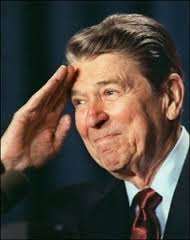
In his Farewell Address, Reagan used the American narrative one final time to advance his philosophy of limited government:
“Ours was the first revolution in the history of mankind that truly reversed the course of government, and with three little words: ‘We the People.’ ‘We the People’ tell the government what to do; it doesn’t tell us.
‘We the People’ are the driver; the government is the car. And we decide where it should go, and by what route, and how fast. . . .
He could also see how the American narrative that he had used so deftly was losing its potency.
“An informed patriotism is what we want. . . Are we doing a good enough job teaching our children what America is and what she represents in the long history of the world? Those of us who are over 35 or so years of age grew up in a different America. We were taught, very directly, what it means to be an American.” . . .
Conservative that he was, he urged a return to the past:
. . . [W]e’re about to enter the ’90s, and some things have changed. Younger parents aren’t sure that an un-ambivalent appreciation of America is the right thing to teach modern children. And as for those who create the popular culture, well-grounded patriotism is no longer the style. Our spirit is back, but we haven’t re-institutionalized it.
We’ve got to do a better job of getting across that America is freedom—freedom of speech, freedom of religion, freedom of enterprise. . . .
Ronald Reagan was right about the 1990s. And telling the American story was changing.
The heroic master narrative was indeed very much “out of fashion” among professional historians and had been for nearly a century. In fact, Reagan’s un-ambivalent view of America’s unblemished past could no longer be sustained.
During the 1990s a new, more complex—and inclusive—narrative burst into public consciousness.
After the Second World War, the study and production of history (and all other fields of learning) was expanded by Roosevelt’s G.I. Bill [this and following links are to wikipedia, unless noted], which vastly increased the number of college-educated Americans.
Among them were new generations of historians who opened new fields of study in areas that reflected their own origins—immigration, ethnic and labor history. By the last decades of the century a new and even more diverse generation of scholars emerged with perspectives and interpretations drawn from the feminist movement, the civil rights movement, and the American Indian Movement.
These new social and cultural historians introduced fundamental changes to the master narrative and their influence began to be seen not only in scholarly work, but also in museum exhibits, popular culture, and eventually, K-12 history education.
This expansion and deepening of the pool of historians complicated the master narrative of American history.
To the old verities were added new facts, evidence, and interpretations. The clash between traditional historical memory and the new scholarship played out in series of public controversies during the 1990s.
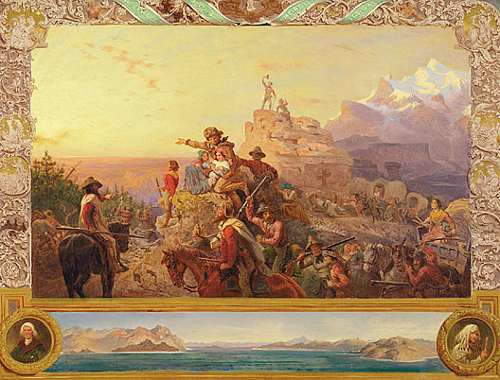
Westward the Course of Empire Takes Its Way [or Westward Ho!], by Emanuel Leutze (1862)
In 1991 The West as America, an exhibit at the Smithsonian Museum of American Art presented 19th century artists’ images of the Old West in the context of new historical interpretations. Westward expansion was presented in terms that challenged the master narrative of the frontier and called attention to the conquest and removal of Native Americans.
A media frenzy and public outcry ensued, followed by threatened cuts to the budget of the Smithsonian Institution by Republican members of the Senate Appropriations Committee, who charged the museum with “politicizing” history. In 1995 another Smithsonian exhibit, this one at the National Air and Space Museum, highlighted deep differences between historical scholarship and popular collective memory about the bombing of Hiroshima and Nagasaki.
The Enola Gay, the plane that dropped the first atomic bomb, was to be the centerpiece of an exhibit rather ponderously entitled “The Crossroads: The End of World War II, the Atomic Bomb, and the Origins of the Cold War.” [link to the Smithsonian Institution]
In an acrimonious public debate that continued for more than a year, veterans’ organizations objected to the museum’s central storyline, which they called “revisionist history.”
In the end, the exhibit was cancelled, but not before congressional funding for the Smithsonian was again threated and the director of the museum was forced to resign. A third major battleground involved National Standards in History for K-12 education. Very much in the spirit of Ronald Reagan’s plea for increased historical literacy, President George H.W. Bush advocated National Education Goals in history, along with new standards in English, math, science, and geography, which had broad bi-partisan and public support.18
So it took many by surprise when in January 1995 the Senate voted 99 – 1, in a “sense of the Senate resolution,” to oppose the National History Standards.
They were voluntary guidelines that had been developed over an inclusive three-year effort funded and co-sponsored by the National Endowment for the Humanities. Nevertheless, shortly before the standards were released, Lynne Cheney, past chair of the NEH and an early champion of them, published a blistering attack in the Wall Street Journal. [link to the University of Michigan]
She charged that the U.S. History Standards presented a “grim and gloomy” portrayal of American history. Why so much attention, she asked, to topics such as the Klu Klux Klan and McCarthyism? Why did this curricular framework save its “unqualified admiration” for “people, places and events” that are politically correct?19
In an op-ed for the New York Times, she declared, “The American history standards make it seem that Joseph McCarthy and McCarthyism (mentioned 19 times) are far more important than George Washington (mentioned twice) or Thomas Edison (mentioned not at all).”20
Cheney’s criticism doomed the effort to establish even voluntary standards for the study of American history. Today’s effort, the Common Core, does not even include history as a stand-alone subject. History/social studies are a subset of “English Language Arts Standards.”
There have been other assaults on the master narrative. And rightly so. The disputes over the Columbian Quincentenary, DNA confirmation that Thomas Jefferson had indeed fathered at least one of the children of his slave, Sally Hemings. The on-going Confederate flag controversy.
Have these new understandings of America’s past negated America’s story? Do we still have a recognizable national narrative sufficient to support a cohesive national identity?

FDR delivering the Four Freedoms Speech
In his Four Freedoms Address in 1941, FDR declared that people must have an “unshakable belief in the manner of life which they are defending.”21
In the aftermath of 9/11, the nation experienced a sense of unity born of tragedy. But recent mass shootings, assaults on African Americans, and the threat of climate change do not produce a sense of urgency needed for united action. Our Congress and our people are torn by division and dissent. Is it because we’ve undone our national story, our national identity?
It could be said that no, we no longer need a national narrative, that the old verities are hopelessly corrupted, proven false by the revealed truth of a hypocritical history. Yet, there is ample evidence that important aspects of the original narrative are still in place, framing our national identity—and thus our public policy both at home and abroad. We debate whether or not the nation is a beacon of freedom and opportunity for the world’s troubled masses. Or whether the working poor and a shrinking middle class undermine the American dream. Indeed, whether in this land of freedom and equality for all, “black lives matter.” Yet these debates occur in an a historical present, divorced from the motivating power of shared historical memory; the kind of memory that was shared and believed to be true by many Americans, a shared history that Roosevelt and Reagan relied on to advance their ideas for a better America.
If that very history is now politically contested, what is our national narrative? On what is it based? Can we or should we be writing a new historical narrative that represents our history truthfully to today’s sophisticated and diverse America?
It must honestly acknowledge our national failings—and use that as a starting point for a new inclusive narrative that situates our high ideals in the energizing diversity of the peoples of the United States. Only then can we expect a united citizenry and effective international leadership.
Cynthia Koch is the former Director of the FDR Presidential Library and Museum, and is now Public Historian in Residence at Bard College.
Notes
1. Joyce Appleby, Lynn Hunt and Margaret Jacob, Telling the Truth About History (New York: W.W. Norton), p. 101.
2. Ibid.
3. Ibid., 104
4. Ibid, 105.
5. Ibid, 112.
6. Ibid., 115.
7. Ibid., 117.
8. Address at the Home of Thomas Jefferson, Monticello, Virginia, July 4, 1936, Public Papers and Addresses of Franklin D. Roosevelt, 1936 Volume: The People Approve, Samuel I. Rosenman, ed. (New York: Random House, 1938), p. 241.
9. Address at the University of Pennsylvania, September 20, 1940, Public Papers and Addresses of Franklin D. Roosevelt, 1940 Volume: War – And Aid to Democracies, Samuel Rosenman, ed. (New York: Macmillan Company, 1941), p. 441.
10. Telephone conversation, Karen Anson, Franklin D. Roosevelt Presidential Library and Museum, with Jennifer Kittraus, George Washington-Mount Vernon Historic Site, January 20, 2006.
11. Address at the Jackson Day Dinner, January 8, 1940, Public Papers and Addresses of Franklin D. Roosevelt, 1940 Volume: War – And Aid to Democracies, Samuel Rosenman, ed. (New York: Macmillan Company, 1941), p. 30.
12. Radio Address on Washington’s Birthday, February 22, 1943, Public Papers and Addresses of Franklin D. Roosevelt, 1943 Volume: The Tide Turns, Samuel I. Rosenman, ed. (New York: Harper & Brothers, 1950), p. 112-13.
13. Radio Address on Washington’s Birthday, February 22, 1943, Public Papers and Addresses of Franklin D. Roosevelt, 1943 Volume: The Tide Turns, Samuel I. Rosenman, ed. (New York: Harper & Brothers, 1950), p. 112.
14. William F. Lewis, “Telling America’s Story: Narrative Form and the Reagan Presidency,” Quarterly Journal of Speech (73) 1987, p. 283.
15. Ibid.
16. Ronald Reagan, Republican National Convention Speech, July 17, 1980. http://millercenter.org/president/reagan/speeches/speech-3406. Accessed August 15, 2016.
17. Ronald Reagan, First Inaugural Address, January 20, 1981. http://millercenter.org/president/reagan/speeches/speech-3407. Accessed August 15, 2016.
18. Gary B. Nash, Charlotte Crabtree, and Ross E. Dunn, History on Trial: Culture Wars and the Teaching of the Past (New York: Alfred A. Knopf, 1997), p. 151.
19. Ibid, p. 4.
20. Lynne V. Cheney, “Mocking America at U.S. Expense,” New York Times, 10 March 1995, p. 29.
21. FDR, Annual Address to Congress, Jan. 6, 1941, Four Freedoms Speech.

